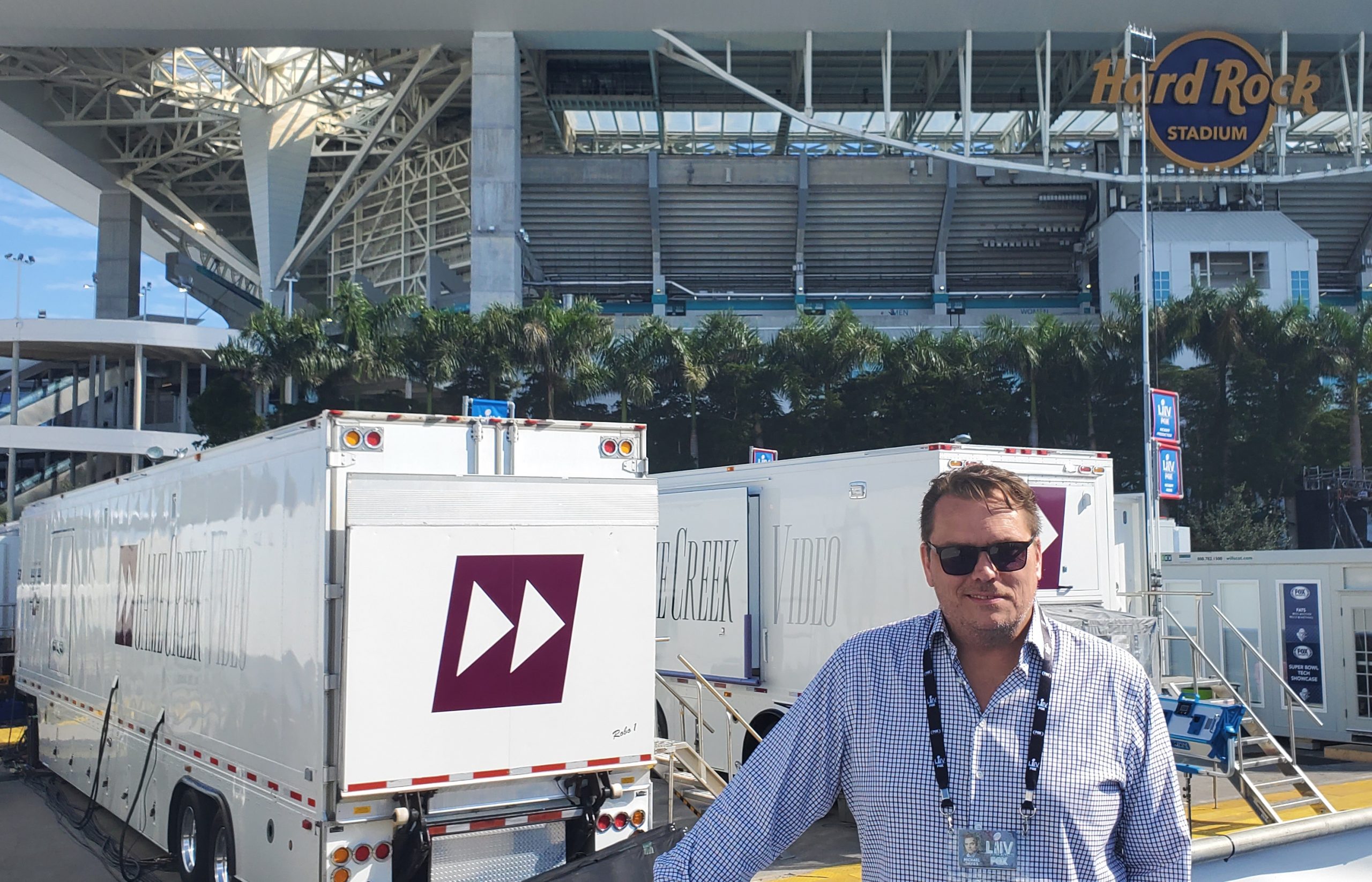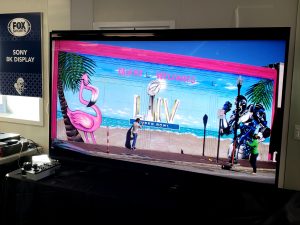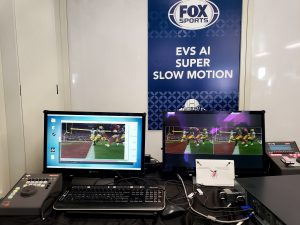Live From Super Bowl LIV: Mike Davies and Fox Sports Team Prepare to Make UHD/HDR History
The Big Game is a major driver of future UHD/HDR-production adoption
Super Bowl LIV is only days away, and with it a new era in Super Bowl broadcasting will begin: the UHD/HDR era. Make no mistake about it: a UHD HDR Super Bowl — and which network would be the first to air it — has been gossip fodder since the first 4K sets hit the CES show floor, and for good reason: the event is a bellwether of the industry’s move to UHD and HDR.
According to Mike Davies, SVP, technical and field operations, Fox Sports, the decision to go UHD and HDR for Super Bowl LIV came from the highest executive levels within the Fox organization. And it was a decision that he is not sure would have made sense early last year.
“The whole evolution of UHD accelerated in 2019, and I’m not sure we would have made the decision to do UHD and HDR in the beginning of the year,” he says. “But, as technology matured — and it matured quickly — it made it more and more possible to conceive of doing Thursday Night Football in 1080p HDR as well as doing the Super Bowl.”
Thursday Night Football was an important reason that Super Bowl LIV is making the UHD/HDR leap. The efforts began in the preseason, and 11 games ultimately were distributed to viewers in UHD and HDR.
“We got comfortable with what we were doing in UHD HDR with the help of people like [Fox Sports, Director, Technical Operations,] Kevin Callahan and [Thumbwar, VP, Special Projects,] Mike Drazin,” he says. “It became clear we could pull this off, and, while it wasn’t easy, we hired the right people to make it happen.”
The commitment to produce and deliver the Super Bowl in UHD HDR began the process to figure out how the team could produce the game in the next-generation format. As in the early days of HD, there are plenty of options, and not all of the elements that make up a production are available for the format.
“We looked at all of the different ways we could have done it,” says Davies. “We could have done a shadow cut with a smaller subset of cameras and upconverted the rest of the cameras. We also looked at doing it in all 4K. Budget [aside], could it be done technically? We even commissioned a consultant to look at it and make sure we were doing it the right way. What they came back with was, not only was 4K going to denigrate the product for the wider audience because of the lack of super-motion, the lack of smaller cameras, and [the] many feeds [but] you would still need to upconvert.”
The bigger issue, however, is that the move to 4K acquisition would actually negatively impact the viewer experience because 4K doubles the pixel offset from one frame to the next. That, ultimately, means more motion blur, which can be a problem for something as fast moving as NFL football.
“At 120 frames per second, 4K looks awesome,” says Davies. “We can shoot it at 120 fps, but we can’t deliver it. At 60 fps, the motion blur is not going to serve the sport well.”
It’s for those reasons that the production of Super Bowl LIV will be completely 1080p and HDR, a move that allows all the cameras and replay feeds to match in terms of quality and also to be upgraded for UHD viewers and downconverted to HD and SD with as little compromise as possible.
“We’ve been evangelizing that concept, and we think, at this point, we are doing this at state-of-the-art,” says Davies. “In 2021, maybe things will be different. It’s incumbent on all the stewards of the Super Bowl to produce the game in the very best way they can at that point in time. I always look forward to the Super Bowl and our chance to raise the bar like CBS did last year and NBC did the year before them.”
Although the production format will be 1080p, 4K and even 8K cameras will be deployed for replay and zoom needs. Eight 4K and three 8K cameras (Sony UHC-8300’s being used in their first NFL postseason game) will be in the mix. The 4K cameras will be at the high-end-zone position and shoot down the line; the 8K cameras will be used exclusively on the sidelines and benches. Two of the 8K cameras will allow up to 12X zoom replays, and the third will shoot the entire field. All three will be coupled with Canon 8K lenses.
“We first used the UHC-8300 at the World Series,” notes Davies. “Sony was great enough to give us the cameras, and Canon was nice enough to give us the lenses.”
A producer and operator will monitor the 8K signals looking for interesting moments, similar to the approach used for the World Series.
“At the World Series, we learned it could be valuable to cover peripheral things, and the benches at a football game are one place where we can’t cover everything,” says Davies. “But, with an extraction device and the 8K cameras and lenses, a producer and operator can find interesting moments on the benches.”
He also looks forward to seeing what an NFL game looks like when shot with a current 8K camera and lens. An 85-in. Sony 8K TV set in the compound will display an 8K image delivered via two Sony PWS-4500 servers that each have four 12-Gbps SDI inputs. The 8K images will be recorded at 60 fps before being passed on to the 8K set.
“We want to see what it looks like when panning and zooming in 8K,” says Davies.
AI Is Tested for Super-Slo-Mo Replay
Another innovation being trialed at Super Bowl LIV is an EVS replay system that uses artificial intelligence to create additional frames in a 60-fps replay, enabling it to have 180 frames per second and be played back as a super-slow-motion replay.
“We are increasingly reliant on small cameras like pylon cameras and ref cams,” says Davies. “Deploying super-slow-motion for cameras that are outside looking in on an event is pretty easy. But, when covering from the inside out, the wireless cameras are smaller, and that’s the sweet spot for this system.”
The system will have access to all the clips that EVS operators create during the game, and the belief is that, eventually, it could become a cloud-based solution.
“We could take advantage of cloud services and push a two- or three-second clip and then get it back,” adds Davies.
The Production/Ops Relationship
All the work that viewers will see on Sunday (actually, all week, given the big role the Fox Sports South Beach sets have played in programming across the Fox sports and news networks) is the result of a long process of push and pull among the production team, the operations teams, the technical team, and third-party vendors.
“A lot of the stuff is done in partnership with production, but it is not always their job to know what is technically possible,” says Davies. “We have to bring some of those concepts to production and ask if it would be cool to do. It’s vital that they buy into it, and it’s a real partnership.”
For viewers on Sunday, that relationship will produce a viewing experience that begins at the South Beach studios and then heads outside of Hard Rock Stadium, where fans will be gathering for pregame festivities. A two-point Flycam will bring viewers directly from outside the stadium to inside the bowl, where more than 70 manned cameras will capture the battle between the San Francisco 49ers and the Kansas City Chiefs.
“We will have a massive amount of super-slow-motion and no true gimmicks,” says Davies. “[Lead Game Producer] Richard Zyontz and [Lead Director] Rich Russo are the best at using super-slo-mo to tell you what is happening and to tell the story of the feelings and emotion. We are stewards of Super Bowl LIV, and the goal is to raise the bar and give our colleagues at CBS Sports something to shoot for next year.”



